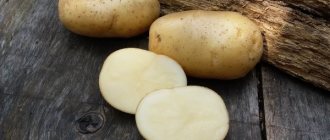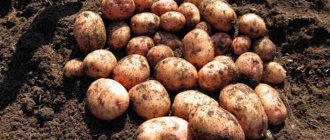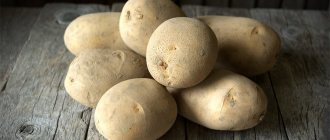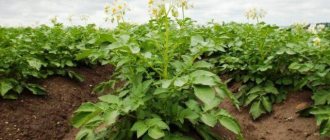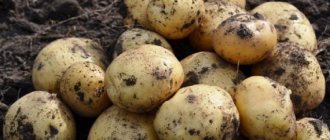Description of the variety
Slavyanka is a mid-season table variety. After the tubers hit the soil and before harvesting, 100-120 days pass.
The variety is high-yielding. On an industrial scale, entrepreneurs often manage to achieve figures of 300-330 centners per hectare. At home you can easily expect 180-280 c/ha.
The variety is unpretentious in care. The only problem when growing it can be poor soil. If the soil is not fertilized enough, then you will not be able to get a good harvest, even with hilling and watering. Otherwise, the variety is completely unpretentious.
Has relatively good immunity. Slavyanka is protected from diseases such as potato cancer, leaf mosaic and the virus that causes leaf curl. Also, potato tubers are rarely affected by a parasite such as a nematode.
What difficulties may there be when growing
In the process of growing Slavyanka, summer residents face such problems as:
- crushing of tubers due to lack of watering;
- rotting of potatoes due to excessive moisture;
- low germination due to improper preparation of seed.
These and a number of other problems can be avoided by following the rules for planting potatoes and subsequently caring for them.
Description of tubers
This variety is excellent for growing for sale. Firstly, tubers can reach incredible sizes up to 250 g. On average, root crops smaller than 90 g are very rare.
Secondly, Slavyanka is well stored. The keeping quality of the variety reaches 95%.
The tuber has a red shell. The flesh is cream-colored. The starch content in the fruit is in the range of 11-13%. That is, potatoes do not become overcooked even with prolonged heat treatments. Ideal for frying, making fries or soups.
Features of cultivation
When growing Slavyanka potatoes, you need to adhere to standard rules of agricultural technology. Watering should be carried out only in the absence of seasonal rains for a long time. It is best to use drip irrigation for this.
A week after planting, the potato bed needs to be loosened to ensure air access to the germinating tubers. You need to hill up Slavyanka bushes twice. The first time at a shoot height of 10-14 cm, and the second time at 20-25 cm.
At an early stage, you need to constantly weed the plantings so that weeds do not take moisture and nutrition from the soil. After the Slavyanka bushes close, the potatoes cope with this task on their own.
During the period of active growth of green mass, plantings should be fertilized with organic matter or ammonium nitrate. And when forming inflorescences and ovaries, use phosphorus-potassium mixtures.
In the southern regions, this variety can be sown 2 weeks earlier
Description of the bush
The bushes are small, medium in size. Spreading is present, but relatively unnoticeable. Leaves cover the stems abundantly. They are large in size, lightly pubescent, and dark green in color.
The inflorescences form several berries. The flowers themselves are bluish-violet with pure white tips.
The root system is well developed. One bush produces from 12 to 15 large root crops. The amount of “peas” is within the minimum.
Slavyanka tubers do not retain nitrates, and the seed material never degenerates. That is, the resulting harvest can be safely used from year to year as planting material, without fear of a decrease in yield.
Characteristics of the potato variety Slavyanka
The Slavyanka variety comes from Ukraine and appeared in the Russian State Register in 2009. Despite her relative youth, Slavyanka has already become popular among gardeners. The variety belongs to a late variety of potato. From planting to ripening of the tubers, 120-140 days pass.
Slavyanka potatoes do not depend much on weather conditions. Recommended for cultivation in the Central Black Earth Region, but also grows in other regions of Russia. The presentation and keeping quality of tubers of the Slavyanka variety are at a high level. The tubers are neat, smooth, do not get soft when cooked and retain their shape. The low starch content allows the tubers to be used for making chips and baking.
The potato bush is spreading, there are few stems, but they branch well. The leaves are dark green, dissected. Flowering is abundant, but short-lived. The flowers are violet-blue.
Positive and negative aspects of the variety
The Ukrainian beauty has become widespread due to its many advantages:
- amazing yields;
- excellent taste;
- simultaneous ripening of tubers;
- resistance to most fungal diseases;
- ease of care;
- high keeping quality;
- excellent product quality.
At the same time, it is worth noting a number of disadvantages:
- potatoes require good soil (for most varieties soil does not matter much);
- tubers are unstable to mechanical stress. This makes harvesting and transport difficult;
- Damaged root vegetables spoil very quickly.
What are the advantages and disadvantages of Slavyanka?
Potatoes of the Slavyanka variety have many positive qualities and a minimum of negative aspects. But before boarding, it is important to carefully read both sides so as not to encounter certain difficulties or lack of knowledge.
Advantages of potatoes:
- resistance to major diseases;
- high taste qualities of tubers;
- unpretentiousness to climatic and weather conditions;
- high productivity;
- versatility of using potatoes;
- friendly ripening of root crops;
- attractive presentation;
- good keeping quality.
The disadvantage of Slavyanka potatoes is the insufficient resistance of the tubers to mechanical damage. Potatoes spoiled during digging are discarded.
Correct fit
Let's start with the fact that experienced gardeners do not recommend planting Slavyanka potatoes for more than 3 years in the same area. It is advisable to change the planting location every 3 years, and instead of potatoes, plant legumes, onions or cucumbers.
They begin to plant potatoes when the soil warms up to a temperature of +9-10 C.
Healthy medium-sized tubers are selected for planting. They must not contain visible defects such as cuts, cracks, stains, rot, etc.
Planting material is planted in holes no more than 20 cm deep. The distance between rows is maintained at 60-70 cm, between holes - 30-40 cm.
If the soil is not fertilized enough, then a handful of wood ash is added to the hole. If it is not there, you can use humus.
Reviews about the Slavyanka potato variety
Krapivnaya Marina Ilyinichna, 42 years old, Bryansk
I grow potatoes for sale. I mainly plant Slavyanka. The variety guarantees high yield with minimal care. Buyers love this variety for its taste and versatility. Suitable for both boiling and frying. For maximum yield, I always feed with manure; I can collect 400-500 centners of excellent potatoes per hectare, which, if properly stored, retain their appearance for up to six months.
Sidorov Ilya Maksimovich, 36 years old, Moscow
For three years now we have been growing Slavyanka potatoes at our dacha. From two acres it turns out half a ton. It stores well, except for those tubers that are “cut” with a shovel. They have to be eaten immediately or discarded. I hill up twice a season. Measures to combat the Colorado potato beetle are standard - we spray them with chemicals. We haven’t noticed any diseases on potatoes in 3 years, but we change the planting location every year.
Rules of care
Slavyanka potatoes, in general, like any other variety, are a rather unpretentious crop. But without proper care you will not be able to get a good harvest. Here are some tips from experienced gardeners:
- Don't forget to hill up the potatoes. If you neglect this procedure, you can lose up to 30% of the harvest. During hilling, the green part of the crop is not only kept from touching the ground, but the area is also cleared and the soil is loosened.
- Don't forget to water. Slavyanka potatoes are good at watering, but without any fanaticism. Only three waterings per season are enough. When the green part has grown by 10-15 cm, at the time of flowering and after it ends.
- In the case of Slavyanka, it requires well-fertilized soil. Therefore, it would be a good idea to add wood ash to the holes when planting tubers.
- Systematically inspect the tops for diseases or parasites.
Reviews from gardeners and vegetable growers
Slavyanka potatoes are popular among gardeners, agrarians and farmers. This is confirmed by the numerous positive reviews that can be found on the Internet.
★★★★★
Anastasia, 34 years old, gardener. I am well acquainted with the Slavyanka variety, it is very popular in our area.
Once I overheard a conversation among my neighbors, where they praised this variety, then I decided to try to grow it on my plot. I found information on the Internet about proper planting and care. And I succeeded! This is the second year I couldn’t be happier. Now my family eats delicious meals, in which I try to add potatoes whenever possible. ★★★★★
Elena, 28 years old, I live in a private house. I had the opportunity to become acquainted with this variety four seasons ago.
After the first landing I was seriously hooked. I liked that after planting the time required for care is minimal. In the first year, I managed to collect 700 kg of potatoes from one hundred square meters. At the same time, there was no need to constantly water the plants. I liked the size of the tubers and their shape. There are almost never small potatoes. During heat treatment, potatoes do not darken and retain their shape when fried. ★★★★★
Ekaterina, 39 years old, engaged in cultivation and sales. A few years ago, I couldn’t even imagine that I would quit my favorite job as an accountant and start growing potatoes for its further sale.
But when I not only grew root vegetables myself for the first time, but also appreciated their taste, I realized “I want everyone to try this variety.” That’s when I decided to get into the “potato business”, and I didn’t regret it - and I always supply potatoes and others myself. By the way, the variety can easily tolerate long distances without losing its presentation. Hide
Add your review
The Slavyanka variety has gained popularity among many gardeners who have been growing the crop for many years. Slavyanka is a variety that guarantees high yields and increased resistance to diseases. The main thing is to follow the recommendations for planting, growing and caring for potatoes.
0
0
Copy link
Harvesting
In order for the harvest to be stored for a long time, firstly, it must be harvested correctly, and secondly, on time. They begin to harvest potatoes when the tops begin to dry out.
Each variety has a certain ripening framework, which is established by breeders. For Slavyanka it is 100-120 days. That is, 10 days before full ripening, approximately 100 days after planting, you can cut off the tops, leaving only 10 cm of the green part. It is also necessary to remove weeds from the site. These procedures are carried out to make it easier to dig up tubers.
We organize competent care of Slavyanka plantings
Caring for the beds is simple; regular watering, hilling, fertilizing, and weeding are required. Additionally, the bushes are treated with drugs against beetles and diseases.
Irrigation and loosening of soil
Slavyanka potatoes need frequent but moderate watering. Bushes are not afraid of drought, if it is short-term. With a regular lack of water, the tubers become smaller. Irrigation manipulations should be carried out during pollen, then after 7-10 days, focusing on the condition of the soil.
See also
Instructions for using Regenta against the Colorado potato beetle
Read
We apply fertilizer for potatoes Slavyanka
Potatoes should be fed to enhance the yield intensity and improve protective functions. The procedure is carried out in stages.
- Before hilling, add 10 g of ammonium nitrate and 300 g of humus. You can also resort to mullein with a ratio of 1:10.
- During budding, the crop requires potassium - 100 g of ash.
- After wilting, for intensive development of tubers, 30 g of superphosphate is taken and diluted in 10 liters of water.
Magnesium is added every 2 weeks during the growing season. The lack of this substance entails a decrease in resistance to pathologies. On neutral or slightly acidic soils, add magnesium sulfate, on acidic ones - dolomite flour 50 g per 1 square meter.
Hilling and mulching beds
Hilling up Slavyanka potato bushes helps saturate the soil with oxygen and nutrients, and activates the growth of side shoots. New fruits are formed, plants are protected from drought and frost, and root crops do not disintegrate.
Carrying out the procedure allows you to remove weeds and loosen the soil.
You can mulch bushes and row spacing with sawdust, hay, peat, and agronomic fiber. A 5-10 cm layer of mulch retains heat, moisture, and prevents the spread of weeds.
Potato diseases and pests: prevention and treatment
Slavyanka potatoes are rarely susceptible to cancer, nematode, scab, late blight, and viruses. To prevent diseases, bushes are treated with copper-containing products. Spraying with Fitosporin and proper preparation of the land for planting help prevent rot and fungus.
Among the pests, the plant is attacked by Colorado potato beetles, mole crickets, wireworms, butterflies, aphids, spider mites, potato moths, and leafhoppers. They are destroyed with insecticides such as Prestige, Anti-Colorada, Aktarofit. Sometimes 3-4 treatments are required.
2 weeks before harvest, spraying with chemicals is not carried out. Infected tops are cut off 2-3 days before harvesting.
Potato diseases and insect pests
The variety is extremely resistant to diseases and pests. It shows excellent immunity to blackleg, wrinkled mosaic, potato cancer, and common scab.
If the care rules are not followed, you may be exposed to:
- Late blight. This disease can spread both to tubers and to the above-ground part of the bush. Root crops begin to rot, dark spots form on the leaves, which subsequently lead to rotting of all greenery.
- Mold. The causes of mold on root crops are considered to be excessive soil moisture.
The development of late blight can be prevented by spraying the bushes with Fitosporin. In advanced cases, the plant is treated with modern insecticidal preparations.
Did you know? A record potato harvest was harvested in 1765 in Novgorod.
Then, from 45 kg of seed material, 3 tons of 740 kg of fruit were obtained. As for pests, Slavyanka is most often subject to “attacks”:
- Colorado potato beetle. It eats potato tubers and greens, due to which the bush slows down its growth and development.
- Wireworm. This parasite, eating everything in its path, forms numerous through holes and small grooves on the skin in the root crops, which negatively affects the taste and aesthetic properties of the tubers.
To combat parasites, it is recommended to use special preparations with a wide spectrum of action, for example, “Aktaru”, “Prestige”, “Thunder”.
Yield and storage
The productivity of Slavyanka is estimated as high - 300 c/ha and above. But to achieve record levels, strict adherence to all recommendations for its cultivation is necessary. The weather also plays a significant role in this case. Harvest occurs in August-September. When the bush begins to wither and the foliage on the stems turn yellow and fall off, it is recommended to cut the tops, removing them from the area. You can dig potatoes 2 weeks later.
It must be remembered that the variety, for all its advantages, is unstable to mechanical stress: the skin of the tubers is easily damaged, after which they become unsuitable for storage. For this reason, extreme care should be taken when harvesting potatoes.
The variety is characterized by high shelf life; the tubers, provided their integrity is preserved, do not lose nutritional value and do not change taste; they can be stored all winter in a dark room at a humidity of no more than 65% and a temperature close to 2oC. Another important condition is the presence of adequate ventilation.
Before storing potatoes, you must:
- dry the tubers thoroughly;
- remove soil residues from them;
- sort through, removing rotten, injured, diseased specimens;
- disinfect the storage by treating its walls and containers for storing potatoes with a 3% solution of copper sulfate;
- thoroughly ventilate the cellar.
It is recommended to immediately select seed potatoes and place them in wooden boxes until next spring. Table potatoes are also placed in wooden containers and covered with any fabric that allows air to pass through well. The thickness of the layer should not exceed 1.5 m. Throughout the winter, the tubers should be periodically inspected, removing any sprouts that have appeared.
If you don’t have a cellar, you can keep potatoes on the balcony in a hermetically sealed container. If stored directly in the apartment, its shelf life will be a month. A small amount of tubers is stored in the refrigerator, in a container intended for vegetables. It is not recommended to use PET bags in which the tubers will get wet.




